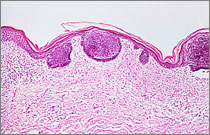Cancer in the central nervous system
| 2022 | ||
|---|---|---|
¹ per 100,000 persons, age-standardised according to the old European standard population * until 1.12.2020 ** calculated using the period method for 2019 / 2020 | ||
| Women | Men | |
| Incidence | 3,128 | 4,176 |
| Age-standardised incidence rate¹ | 5.2 | 7.7 |
| Deaths | 2,628 | 3,357 |
| Age-standardised mortality rate¹ | 3.7 | 5.6 |
| 5-year prevalence* | 6,000 | 7,500 |
| 10-year prevalence* | 9,700 | 11,200 |
| Relative 5-year survival rate** | 23 % | 21 % |
| Relative 5-year survival rate** | 18 % | 17 % |
Cancers of the central nervous system (CNS) affect the brain in 95 percent of cases. The remaining 5 percent are distributed among the cranial and spinal meninges, cranial nerves and spinal cord.
CNS tumours can occur at any age. In adults, the predominant histological type of CNS tumour is glioma, originating from the supporting tissue of the nerve cells. Of these, nearly three quarters are glioblastomas (astrocytoma grade IV) with an unfavourable prognosis. Among infants and toddlers, however, embryonic tumours are the predominant histological type.
In 2022, approximately 3,130 women and 4,180 men in Germany were diagnosed with a malignant tumour of the CNS. Since 1999, no substantial changes in age-standardised incidence or mortality rates have been observed.

![]() Age-standardised incidence and mortality rates by sex, ICD-10 C70-C72, Germany 1999-2018/19, projection (incidence) through 2022, per 100,000 (old European Standard)
Age-standardised incidence and mortality rates by sex, ICD-10 C70-C72, Germany 1999-2018/19, projection (incidence) through 2022, per 100,000 (old European Standard)
The relative 5-year survival rates for malignant CNS tumours are 21 percent for men and 23 percent for women. These figures do not include histologically benign CNS tumours or those of uncertain or unknown behaviour, which, depending on their location, can also lead to complications or even death. A total of approximately 7,000 such tumours are estimated to be diagnosed each year, of which nearly two thirds originate from the meninges. Women are affected much more frequently.
Little known about risk factors despite research
The causes of the various brain tumours are still largely unclear. Patients with very rare hereditary tumour syndromes have a substantially increased risk of developing a brain tumour. After therapeutic irradiation of the head, the risk of developing a brain tumour is slightly increased after a long latency period. Radiation therapy in childhood and adolescence is a particular risk factor. Computer tomography in childhood might also slightly increase the risk of a brain tumour.
A clear connection between mobile phone use and brain tumours has not been proven so far. However, an increased risk cannot be excluded beyond doubt, particularly for heavy and frequent mobile phone or smartphone users. According to current knowledge, no increased risk is conferred by viruses, toxic substances or lifestyle factors such as smoking or alcohol.
First-degree relatives of persons with brain tumours have a slightly increased risk of developing a brain tumour themselves. Genetic traits may be involved here.
Date: 17.12.2024






